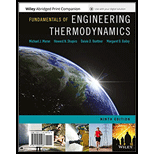
Concept explainers
The reason why the aerodynamic coefficient of drag of a formula one race is greater than an ordinary automobile.
Answer to Problem 2.1E
The aerodynamic drag coefficient of a formula one race car is often substantially higher than that of a regular car.
Explanation of Solution
The drag coefficient is a non-dimensional quantity that is used to assess an item's drag or resistance in a wet environment such as ambient air. The object will have substantially less aerodynamic drag if it has a low drag coefficient. The coefficient of drag is always proportional to the surface area.
The drag depends on many factors such as density, viscosity, compressibility, the square of the velocity, body inclination, and size.
The relationship between body form, inclination, air viscosity, and compressibility is complicated in general. This is represented by the drag equation. The drag is as follows:
Where,
A is the reference area
V is the velocity of an object
From the above equation, it is observed that aerodynamic drag increases with the square of the speed. The speed of the formula one car is much greater than the speed of the ordinary automobile.
Want to see more full solutions like this?
Chapter 2 Solutions
FUND OF ENG THERMODYN(LLF)+WILEYPLUS
- Define the Energy can cross the boundaries of a closed system in the form of heat and work?arrow_forwardA car traversing along Taft Avenue consumes 12 liters of gasoline per 100 kilometers. What amount of carbon dioxide is produced by the car?arrow_forwardHow do the principles of kinetics influence innovations in transportation? How is the motion of the objects describe through graphs?arrow_forward
- A pure crystalline substance at absolute zero temperature is in perfect order, and its entropy is zero (the third law of thermodynamics).arrow_forwardJ 5 By polytropic process, isothermal process or adiabatic process to press the ideal gas from same p1 to same p2, which process has the maximum final temperature? Give some explanation. By polytropic process, isothermal process or adiabatic process to press the ideal gas from same p1 to same p2, which process has the maximum final temperature? Give some explanation.arrow_forward
 Elements Of ElectromagneticsMechanical EngineeringISBN:9780190698614Author:Sadiku, Matthew N. O.Publisher:Oxford University Press
Elements Of ElectromagneticsMechanical EngineeringISBN:9780190698614Author:Sadiku, Matthew N. O.Publisher:Oxford University Press Mechanics of Materials (10th Edition)Mechanical EngineeringISBN:9780134319650Author:Russell C. HibbelerPublisher:PEARSON
Mechanics of Materials (10th Edition)Mechanical EngineeringISBN:9780134319650Author:Russell C. HibbelerPublisher:PEARSON Thermodynamics: An Engineering ApproachMechanical EngineeringISBN:9781259822674Author:Yunus A. Cengel Dr., Michael A. BolesPublisher:McGraw-Hill Education
Thermodynamics: An Engineering ApproachMechanical EngineeringISBN:9781259822674Author:Yunus A. Cengel Dr., Michael A. BolesPublisher:McGraw-Hill Education Control Systems EngineeringMechanical EngineeringISBN:9781118170519Author:Norman S. NisePublisher:WILEY
Control Systems EngineeringMechanical EngineeringISBN:9781118170519Author:Norman S. NisePublisher:WILEY Mechanics of Materials (MindTap Course List)Mechanical EngineeringISBN:9781337093347Author:Barry J. Goodno, James M. GerePublisher:Cengage Learning
Mechanics of Materials (MindTap Course List)Mechanical EngineeringISBN:9781337093347Author:Barry J. Goodno, James M. GerePublisher:Cengage Learning Engineering Mechanics: StaticsMechanical EngineeringISBN:9781118807330Author:James L. Meriam, L. G. Kraige, J. N. BoltonPublisher:WILEY
Engineering Mechanics: StaticsMechanical EngineeringISBN:9781118807330Author:James L. Meriam, L. G. Kraige, J. N. BoltonPublisher:WILEY





